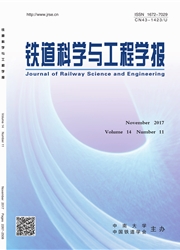

 中文摘要:
中文摘要:
由于构成无辟轨道主体结构的材料为混凝土等热的不良导体和温度敏感材料,无辟轨道内部温度场的分布特性受 环境影响很大,且对无砟轨道受力状态有较大影响,而目前关于无砟轨道温度场的系统研究刚刚开始,急需建立一套合理可行的无辟轨道温度场监测方法为温度应力的计算和无辟轨道设计提供真实可靠的基础参数.为在制定监测方案时合理确定测点位置,对双块式无砟轨道温度场进行了有限元模拟和实测,通过对无砟轨道温度场分布特性分析对混凝土内部温 度传感器的布设提出建议.研究结果表明:轨道结构对称部位的温度分布基本相同,轨道结构边角部分温度变化幅度较大:距侧边约30cm以上的轨道结构内部温度场分布基本相同,在场地有限的情况下,可建立较小的试验段进行测试,要获 取无砟轨道整体温度梯度参数,测点布置应距板边至少30cm以上:采用钢筋、木条等热传导性与混凝土差别较大的材料作为温度传感器附着物时测得的轨道结构温度场同轨道结构实际情况有一定差别,应尽量选择与混凝土类似的材料作为 温度传感器的附着物.
 英文摘要:
英文摘要:
Ballastless track is a composite structure made of reinforced concrete material.Because of the thermal conductivity properties of track structure,the change of surrounding environmental conditions affects the tempera-ture field and stress of track.The systematic study of ballastless track temperature field has just begun.In order to provide reliable parameters for the calculation of temperature stress and ballastless track design, it needs to estab-lish a set of methods to monitor ballastless track temperature field.The measured data and the results of numerical simulations show that the temperature distribution of the symmetric part of the structure is basically the same,and the marginal part of the track structure have large variation in concrete temperature. More than about 30 cm from the track side,the temperature field distribution inside the track structure is basically the same.Due to the limited testing ground, establishing a small test model for the test is acceptable.The temperature field data measured by the method of installing sensors on different kinds of materials, such as steel, wood etc, have a certain difference from the actual situation of track structure.
 同期刊论文项目
同期刊论文项目
 同项目期刊论文
同项目期刊论文
 期刊信息
期刊信息
